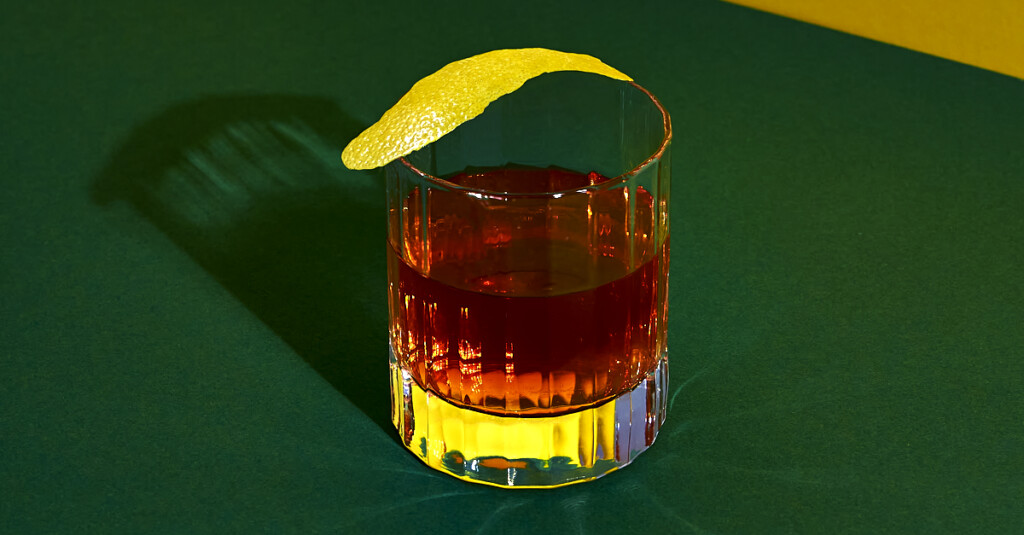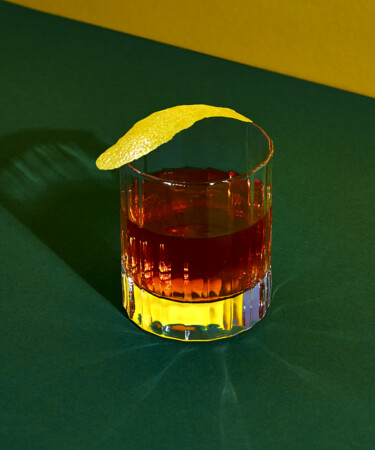This beloved cocktail recipe is deeply intertwined with New Orleans' cultural history. The Sazerac is also one of the 50 most popular cocktails in the world. To discover the other 49, check out the full list.
Need the right rye? See our picks for the best ryes for Sazeracs!
Table Of Contents
Sazerac Ingredients
- 3 oz Rye or Brandy
- 1/2 oz Demerara syrup
- 10 dashes Peychaud's Bitters
- 1 ea Lemon twist
- As needed Absinthe
Sazerac Directions
- Combine all ingredients in mixing glass with ice.
- Stir.
- Strain into chilled rocks glass rinsed with absinthe, with no ice.
- Garnish with lemon twist and enjoy.
Rate This Recipe:
Yield: 1 Cocktail
Calories: 136
Updated: 2024-04-22

Sazerac FAQ
What is the difference between an Old Fashioned and a Sazerac?
Whereas the Old Fashioned uses bourbon as its base, the Sazerac is made with rye whiskey or brandy. Further, the Sazerac calls for Peychaud’s bitters in place of the Old Fashioned’s Angostura bitters. Plus, while an Old Fashioned uses standard simple syrup as a sweetening agent, the Sazerac calls for Demerara syrup. It’s garnished with only a lemon twist, compared to the Old Fashioned’s lemon and orange twist. Lastly, the Sazerac calls for an absinthe-rinsed glass; the Old Fashioned does not.
Should a Sazerac use Rye or Cognac?
A Sazerac can be made with either rye whiskey or brandy, therefore Cognac — a type of brandy — can be used as the cocktail’s base.
Can you drink a Sazerac on the rocks?
While you can drink your cocktail however you like, the Sazerac is a cocktail best served straight up. We suggest serving the cocktail strained into a chilled, absinthe-rinsed rocks glass.
What does a Sazerac taste like?
Primarily, a Sazerac is going to taste like whichever base spirit you choose — whiskey or brandy. However, the flavor is balanced by the herbal notes of bitters with a very subtle citrus aroma from the lemon twist.
Best Practices: Sazeracs Are Boozy but Balanced
“It is consistently the most inconsistently made cocktail in the world,” Chris Hannah, proprietor of New Orleans’ Manolito and Jewel of the South, says of the Sazerac. “Everyone and every bar does something differently.”
Hannah would know. The Sazerac has deep roots in his city, and some historians believe the Sazerac was America’s first cocktail, created by a Haitian-American pharmacist in New Orleans in the 1830s (or was it the 1880s?).
The debate over how to properly make this drink is understandable because the Sazerac recipe has evolved over the years. It began as a Cognac vehicle, but today, most bartenders make Sazeracs by rinsing a glass with absinthe and combining rye, simple syrup, and bitters, and finishing it with a twist.
For those looking to make consistently great Sazeracs at home, we asked Hannah and five other bar professionals for their top tips. Here is everything you need to know to get your Sazerac just right, every time.
What to do when making a Sazerac
Chill the glass.
Since this drink is served “down” (bartending-speak for chilled but without ice), you want to get your glassware as cold as possible. This might seem fussy — and it does require at least 30 minutes’ advance planning to wedge a glass into the freezer — but it’s a vital step before your absinthe rinse.
“Without chilling the glass, the absinthe will sink and mix into the cocktail,” Eileen Chiang, beverage manager and assistant general manager at Wayan in NYC, says. If that happens, the heavy flavors of absinthe will overpower the rest of the drink.
“You want to be able to smell the absinthe instead of having it hit your tongue. Smelling it will dry out the cocktail without having it numb your palate,” Chiang adds.
Use a strong base spirit.
In any mixed drink, alcohol content matters because it balances sweetness and acidity. Sazeracs are boozy cocktails, so the proof of your rye (or Cognac) needs to offset the other components.
“I prefer my base spirit to be around 100 proof for my Sazeracs,” says Leo Robitschek, bar director and managing partner of Make It Nice, the restaurant group that includes NYC’s Eleven Madison Park and NoMad locations in New York, Los Angeles, and Las Vegas. “Not all whiskies and Cognacs are the same, and the most expensive is not always the best. Make sure to choose your spirit blends wisely, and by flavor profile.”
VinePair’s favorite rye for Sazeracs, aptly named Sazerac 6 Year, clocks in at 90 proof and less than $40.
Give Cognac a try.
If you happen to have a bottle of Cognac lying around the house, this is a great opportunity to make what Alex Holder, of McGuire Moorman Hospitality in Austin, Tex., calls “the OG version” of the Sazerac.
When you’re making a Sazerac with Cognac, however, it’s not an even trade. Since rye is more alcoholic (80 to 100 proof, versus Cognac’s 60 proof), you’ll want to tweak your other ingredients accordingly.
“Do give Cognac as the base spirit a shot, and when you do, use absinthe to up the proof,” Hannah suggests. Robitschek agrees, noting that you can balance a lower-proof base spirit like Cognac by adding others “to make up the difference.”
Both versions have their merits. “Rye will provide a dry, spicy profile and Cognac will be sweeter and juicy because of its base product, grapes,” Ryan Lindquist, bar manager at LUXBAR in Chicago, says.
Rinse. Every time.
“A proper absinthe rinse is crucial to balancing the cocktail,” Chiang says. Don’t believe us? Try making two Sazeracs, one with an absinthe rinse and one that has never touched absinthe. The former will have a beautiful, aromatic nose and balanced flavors. The absinthe-free version will taste, well, boozy.
If you don't have a bottle in your home bar, Johnny Swet, owner of Brooklyn's Grand Republic Cocktail Club, recommends St. George.
What to avoid when making a Sazerac
Don’t skip the citrus.
Some bartenders like to leave the lemon twist in, whereas others simply express it over the top of the drink and then discard it. All agree, however, that the presence of lemon adds necessary flavor and acidity to this very boozy drink.
If you do decide to leave the twist in the finished cocktail, Chiang notes that “the size of the lemon peel matters… Having a peel that’s too large or has too much pith can overpower the cocktail with bitterness from the oils coming from the fruit.”
There are aesthetic reasons to leave the twist in, too. “Color contrast is a beautiful thing,” Hannah says.
All bitters are not the same.
“You must use Peychaud’s,” Swet says. Chiang agrees: “Never Angostura bitters, Peychaud’s only!” Best of all, by sticking with New Orleans' signature bitters, you'll ground this often-consistently made cocktail in homegrown tradition.
Sazerac Variations To Try:
- The Cognac Sazerac - New Orleans' history-making Sazerac cocktail gets a retro-futuristic reboot in this variation featuring Cognac, Herbsaint liqueur, and spicy Creole bitters.
- The Pernola - The Sazerac, a classic cocktail from New Orleans, gets a reboot with rye, Peychaud's simple syrup, and orange bitters.
